Celebrating Smart Home Day – November 3, 2025
Today marks Smart Home Day, a perfect opportunity to explore how the right cabling infrastructure transforms ordinary houses into intelligent, connected living spaces. Whether you’re a homeowner considering your first smart device or a professional installer working on comprehensive automation projects, understanding the cable foundations that make smart homes work is more important than ever.

How to Convert Your Normal Home to a Smart Home with the Right Cables
Smart home devices are transforming everyday living, but even the most advanced technology depends on one critical foundation: proper cabling infrastructure. Whether you’re installing smart home security systems, setting up automation controls, or building an integrated smart home ecosystem, understanding the cable requirements is essential. Vertical Cable provides the complete range of low-voltage and fiber optic cables needed to power your connected home.
What Are the Requirements for a Smart Home? Starting with Proper Cabling
When homeowners ask “what qualifies a home as a smart home,” the answer often focuses on devices like smart thermostats, security cameras, and voice assistants. However, professional installers and smart home companies know that reliable cabling infrastructure is the true foundation of any robust smart home system. While wireless connectivity offers convenience, hardwired connections using quality cables from manufacturers like Vertical Cable ensure superior reliability, security, and performance.
Smart Home Device Connections: Essential Cable Types Explained
Security & Access Control Cables for Smart Home Safety
Smart Home Door Locks and Electric Access Control
Smart home locks and electric door locks require dependable low-voltage connections. Vertical Cable’s access control cables (22/4, 18/6) are specifically designed for these applications, providing:
- Reliable power delivery to electromagnetic and electronic locks
- Stable connections for keypads, card readers, and biometric scanners
- Integration with smart home control panels and apps
- Weather-resistant options for exterior installations
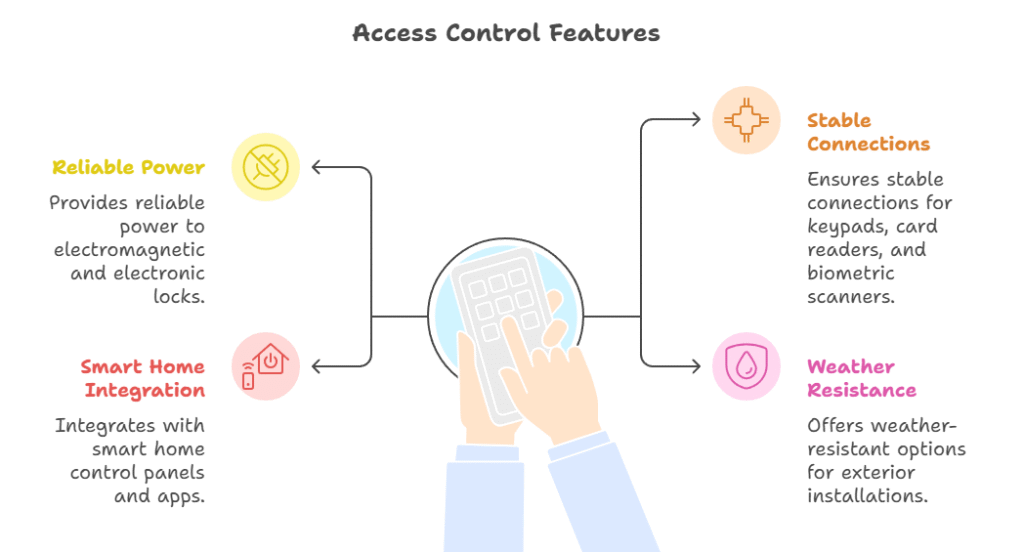
According to Security Sales & Integration, properly cabled access control systems reduce false alarms and improve system longevity compared to purely wireless solutions.
Smart Home Camera Systems: Choosing Between IP and Analog
For smart home camera installations, cable selection depends on your system type:
- IP Security Cameras: CAT5e or CAT6 cables provide both power (via PoE) and high-definition video transmission
- Analog Security Systems: Siamese coax cable (RG59 + 18/2) delivers video signals and power simultaneously
- Long-Distance Installations: Fiber optic cables enable 4K and higher resolution cameras over extended distances
Vertical Cable offers comprehensive solutions for both commercial and residential smart home camera systems, ensuring your security footage remains clear and reliable.
Smart Home Alarm Systems and Fire Detection
Fire Alarm and Security System Cabling
Smart home fire alarms and security systems require specialized fire-rated cables that meet National Electrical Code (NEC) requirements. Vertical Cable’s fire alarm cables (FPL, FPLR, FPLP) are designed for:
- Smoke detectors and heat sensors
- Motion detectors and door/window sensors
- Alarm control panels and keypads
- Sirens and notification devices
- Integration with smart home monitoring systems
Smart Home Automation Control Cables
Smart Thermostat and HVAC Control
Smart home energy management starts with your HVAC system. Vertical Cable’s 18/5 and 18/8 thermostat wires provide the necessary connections for:
- Smart thermostats (Nest, Ecobee, Honeywell)
- Zone control systems
- Humidifier and dehumidifier integration
- Smart home energy monitoring systems
- Multi-stage heating and cooling controls
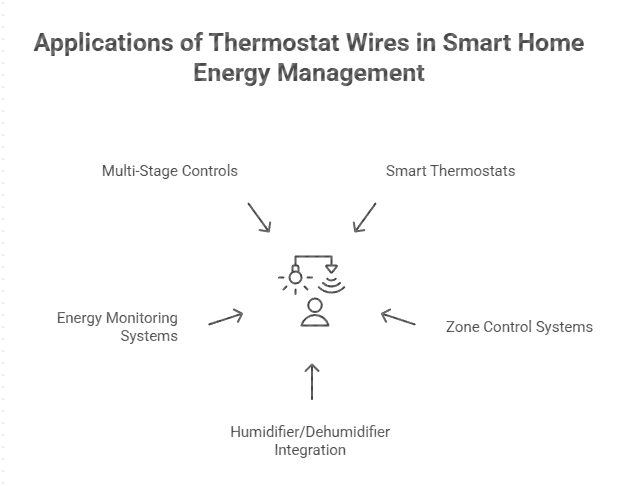
According to the U.S. Department of Energy, properly installed smart thermostats can reduce heating and cooling costs by 10-30% annually.
Limited-Time Thermostat Wire Promotion
By the way, Vertical Cable is currently offering a special promotion on thermostat wire — perfect timing for Smart Home Day! Take advantage of Vertical Cable’s Thermostat Wire Promotion, available November 1 – November 26.
This offer covers our complete lineup of 18 AWG and 20 AWG thermostat wire (3 to 8 conductors), CL2R (Riser) and CL2P (Plenum) rated, featuring solid bare copper construction for reliable performance in residential and commercial HVAC systems. Available in white and brown finishes.
Promo Details:
- Orders over $1,000 — 8% Discount
- Orders under $1,000 — 5% Discount
Now’s the perfect time to stock up on professional-grade thermostat wire — durable, flexible, and easy to install. Whether you’re upgrading to a smart thermostat system or working on new construction projects, this promotion makes it more affordable to use quality Vertical Cable products.

Smart Home Lighting Systems
From smart home light switches to complete lighting control systems, proper cabling ensures seamless operation:
- Low-Voltage LED Lighting: 12/2 and 14/2 wire for landscape and accent lighting
- PoE Lighting: CAT6A cables for network-controlled LED systems
- Dimmer Controls: Specialized wiring for smart home dimmer switches
- Outdoor Smart Lights: Direct burial cables for weatherproof installations
Smart Home Entertainment and Communication
Intercom Systems and Video Doorbells
Modern smart home intercom systems and video doorbells require reliable data and power connections. Vertical Cable’s solutions include:
- CAT5e/CAT6 for IP-based intercom systems
- 22/4 and 18/6 cables for traditional intercom installations
- Shielded options for noise-free audio transmission
- Compatible with Ring, Nest Hello, and other smart doorbell systems
Outdoor Speakers and Multi-Room Audio
Creating an immersive smart home audio experience requires quality speaker cables:
- 16/2, 14/2, and 12/2 speaker wire for various distances
- Burial-rated options for outdoor smart home speaker installations
- Low-loss cables for maintaining audio quality
- Compatible with Sonos, Bose, and other smart audio systems

Fiber Optic Cables: Future-Proofing Your Smart Home Network
When to Choose Fiber for Smart Home Applications
While copper cables serve most smart home device connections, fiber optic cables are increasingly important for:
Smart Home Internet Backbone
- FTTH (Fiber to the Home): Loose tube fiber provides gigabit and multi-gigabit internet speeds
- Inter-Building Connections: Campus-style properties benefit from fiber connections between structures
- Future-Proof Bandwidth: Fiber handles increasing data demands from 4K cameras, VR systems, and emerging technologies
High-Performance Smart Home Applications
- 4K/8K Security Camera Systems: Long cable runs exceeding CAT6 distance limitations
- Smart Home Data Centers: Connecting network equipment and servers
- Commercial Smart Buildings: Large-scale automation and BMS (Building Management Systems)
Vertical Cable offers both loose tube fiber (for outdoor/underground installations) and tight-buffered fiber (for indoor applications), ensuring the right solution for every smart home scenario.
Understanding Loose Tube vs. Tight-Buffered Fiber
Loose Tube Fiber is ideal for:
- Direct burial smart home installations
- Aerial cable runs between buildings
- Long-distance connections (over 300 feet)
- Harsh environmental conditions
- Underground conduit installations
Tight-Buffered Fiber works best for:
- Indoor smart home networking
- Shorter cable runs within buildings
- Easier termination and splicing
- Distribution within equipment rooms
- Connecting smart home hubs and controllers

Smart Home Hub and Controller Connectivity
What Is Smart Home Compatibility? Cable Considerations
Smart home hubs (like Samsung SmartThings, Amazon Echo, or Apple HomePod) coordinate various smart home devices. While many hubs connect wirelessly to devices, they require reliable hardwired connections for:
- Power: Consistent, interference-free power delivery
- Network Backbone: Ethernet connections for reliable hub-to-cloud communication
- Device Integration: Hardwired connections for critical devices like security panels
Vertical Cable’s CAT6 and CAT6A cables provide the network backbone these systems need for optimal performance.
Smart Home Installation: Professional vs. DIY Considerations
Do I Need an Electrician for Smart Home Cabling?
While many smart home devices offer DIY installation, proper cabling often requires professional expertise:
When to Hire Smart Home Installers:
- Running cables through walls, attics, or crawl spaces
- Installing fire alarm or security system cables (often requiring licensed technicians)
- Fiber optic terminations and splicing
- Integrating with existing electrical systems
- Ensuring code compliance and permit requirements
DIY-Friendly Cable Projects:
- Surface-mounted cable runs
- Simple CAT6 installations for smart home devices
- Doorbell and camera installations using existing wiring
- Thermostat wire upgrades
The Consumer Technology Association recommends consulting with certified smart home installation companies for complex projects to ensure safety, reliability, and warranty protection.
How Much Does It Cost to Turn Your House into a Smart Home?
According to HomeAdvisor, the average cost to convert a normal home to a smart home ranges from $2,000 to $8,000, with cabling representing 20-40% of total costs.

Smart Home Network Setup: Creating a Robust Infrastructure
The Three Basic Components of Smart Home Cabling
- Power Delivery Cables: Low-voltage wires that power smart devices (thermostats, locks, sensors)
- Data Transmission Cables: Network cables (CAT5e/CAT6) and fiber that enable device communication
- Control Signal Cables: Specialized cables for alarm systems, intercoms, and access control
Vertical Cable provides complete solutions across all three categories, ensuring compatibility and performance throughout your smart home system.
Can a Smart Home Work Without Internet? The Role of Hardwired Connections
One common question about smart home reliability is: “can smart home work without internet?” The answer depends significantly on your cabling infrastructure:
Locally-Controlled Systems: Hardwired smart home automation using cables for device-to-device communication can function independently of internet connectivity:
- Wired alarm systems continue monitoring
- Hardwired lighting controls maintain operation
- Local network devices communicate via CAT6 connections
Cloud-Dependent Systems: Many wireless smart home devices require internet for full functionality, but proper cabling ensures:
- Faster restoration when internet returns
- Reliable power during connectivity issues
- Better overall system resilience
Smart Home Security: Are Smart Home Devices Safe?
Cybersecurity Benefits of Hardwired Connections
When people ask “are smart home devices safe,” cabling plays an important role in security:
Hardwired Advantages:
- Reduced wireless attack surface
- No Wi-Fi password vulnerabilities for wired devices
- Physical security through concealed cable runs
- Immunity to wireless jamming attempts
Best Practices: According to CISA (Cybersecurity & Infrastructure Security Agency), combining hardwired and wireless smart home devices with network segmentation provides optimal security. Vertical Cable’s shielded and fire-rated cables add physical security layers to your smart home network.
Smart Home for Seniors and Accessibility Applications
Aging-in-Place Smart Home Solutions
Smart home for elderly and aging in place applications require reliable cable infrastructure for:
Safety Systems:
- Medical alert systems and fall detection
- Smart home fire alarms with enhanced notifications
- Automated door locks for emergency responder access
- Smart home security cameras for remote monitoring
Daily Living Support:
- Voice-controlled lighting and climate control
- Smart home medication reminders
- Remote health monitoring devices
- Video communication systems for family check-ins
Vertical Cable’s durable, long-lasting cables ensure these life-critical systems remain operational when seniors need them most.
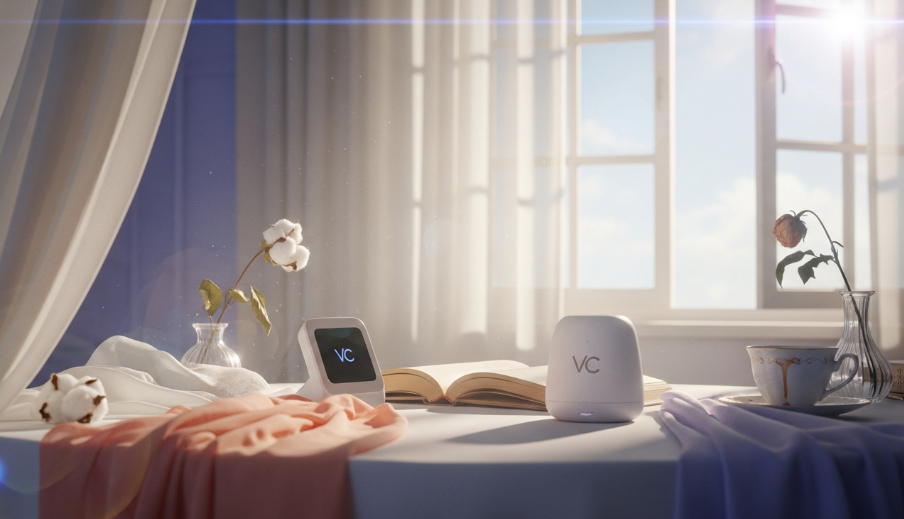
Smart Home Brands and Ecosystem Compatibility
Which Smart Home System Is Best for Your Cable Infrastructure?
Popular smart home ecosystems have different cabling requirements:
Apple HomeKit Smart Home:
- Emphasizes Thread and Matter protocols (wireless)
- Requires robust network backbone (CAT6/CAT6A recommended)
- Benefits from hardwired HomePod hubs
Amazon Alexa Smart Home:
- Zigbee integration built into Echo devices
- Mixed wired/wireless deployment
- Hardwired Echo devices improve mesh network performance
Google Home Smart Home:
- Heavy cloud dependence requires reliable internet
- Wired Nest cameras outperform wireless versions
- CAT6 to Nest Hub Max recommended
Samsung SmartThings:
- Hybrid hub supports multiple protocols
- Ethernet connection to hub is critical
- Extensive wired device support
Regardless of ecosystem choice, Vertical Cable provides the infrastructure cables needed for optimal smart home system performance.
Smart Home Installation Companies: What to Look For
Professional Certifications and Standards
When selecting smart home installers near me, verify they use quality cables meeting industry standards:
Cable Standards:
- TIA/EIA-568 for structured cabling
- NEC Article 725 for low-voltage installations
- NEC Article 760 for fire alarm systems
- UL listing for safety compliance
Professional Certifications:
- CEDIA (Custom Electronic Design & Installation Association)
- BICSI (Building Industry Consulting Service International)
- State electrical or low-voltage licensing
Vertical Cable products meet or exceed all relevant industry standards, making them the preferred choice of professional smart home companies.
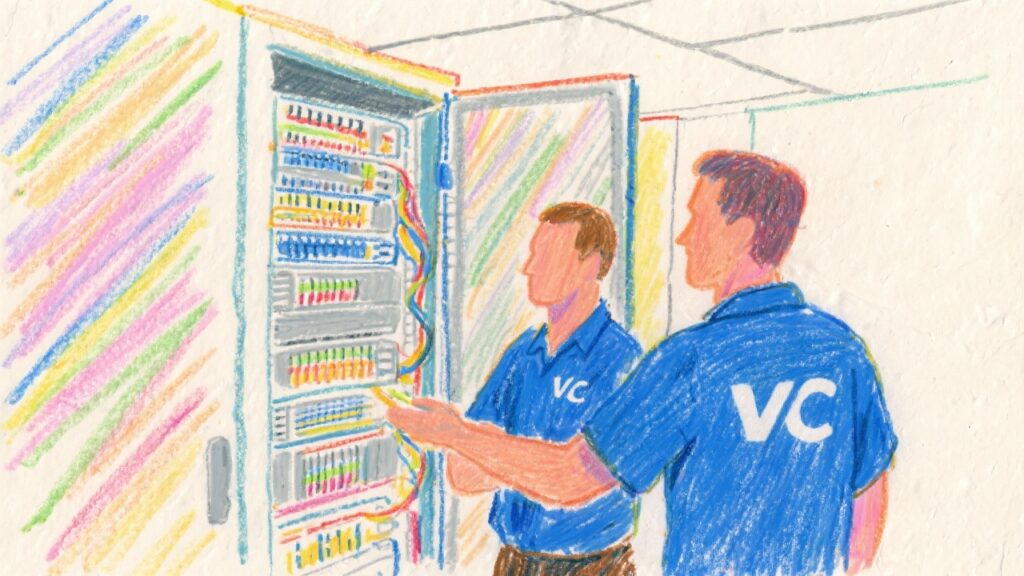
Smart Home Energy Solutions: Monitoring and Management
Smart Home Energy Monitor Cabling
Smart home energy monitoring systems require specific cabling for:
Electrical Panel Connections:
- Current transformers (CT) wiring
- Communication cables to monitoring devices
- Network connections for cloud data upload
- Integration with smart home control systems
Energy Management Devices:
- Smart home electrical panel breakers
- EV charging station connectivity
- Solar panel system monitoring
- Battery backup system integration
According to EnergyStar, homes with comprehensive energy monitoring reduce consumption by 5-15% through better awareness and automation.
Smart Home Automation System Design Best Practices
Planning Your Cable Infrastructure
New Construction Considerations:
- Install conduit for future cable upgrades
- Home run cables to central distribution point
- Use CAT6A for future-proofing (supports 10 Gigabit)
- Specify Vertical Cable products in building specifications
Retrofit Installations:
- Assess existing wiring for reuse opportunities
- Plan cable paths minimizing drywall damage
- Consider wireless for challenging locations
- Use plenum-rated cables in air handling spaces
Smart Home for Apartments and Renters: For smart home for renters and apartment dwellers with installation limitations:
- Focus on plug-and-play devices with minimal wiring
- Use surface-mount cable management solutions
- Prioritize reversible installations
- Document all modifications for lease compliance
Vertical Cable: Your Smart Home Cabling Partner
Why Choose Vertical Cable for Smart Home Projects?
Product Range:
- Comprehensive selection of low-voltage cables
- Specialized smart home application cables
- Fire-rated and plenum-rated options
- Indoor and outdoor solutions
- Fiber optic cables for high-performance needs
Quality Assurance:
- UL listed and industry certified products
- Rigorous quality control processes
- Consistent performance across product lines
- Technical support for installers and integrators
Industry Expertise:
- Decades of experience in commercial and residential cabling
- Partnerships with leading smart home brands
- Ongoing product development for emerging technologies
- Educational resources for installers and end-users
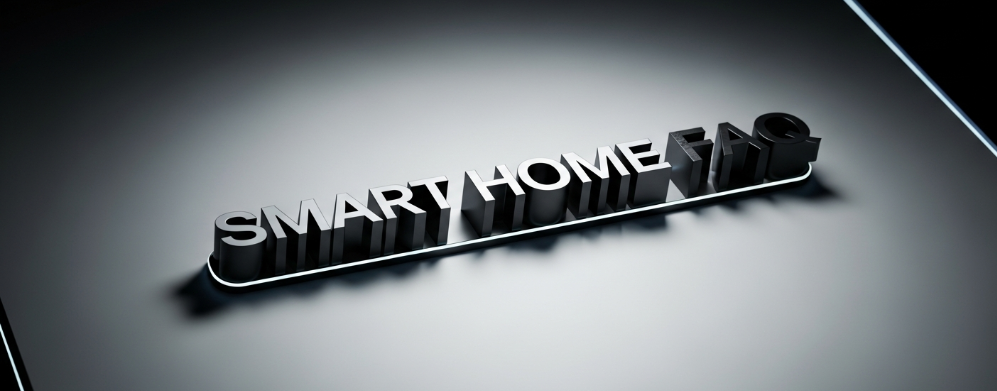
Frequently Asked Questions About Smart Home Cabling
What exactly is a smart home?
A smart home is a residence equipped with interconnected devices that can be monitored, controlled, and automated remotely or through voice commands. While many focus on the devices themselves, the underlying cable infrastructure is what enables reliable communication between components. A true smart home combines wireless convenience with hardwired reliability using quality cables from manufacturers like Vertical Cable.
What is a smart home and how does it work?
Smart home systems work by connecting various devices through a central hub or controller, allowing them to communicate and be controlled as an integrated system. While wireless protocols like Wi-Fi, Zigbee, and Z-Wave enable many connections, critical infrastructure relies on hardwired cables for power delivery, network backbone, and high-bandwidth applications. Vertical Cable’s low-voltage and fiber optic solutions provide the foundation that makes smart home automation reliable and responsive.
What qualifies a home as a smart home?
A home qualifies as a smart home when it features multiple connected devices that enhance convenience, security, energy efficiency, or entertainment. The sophistication ranges from basic (smart thermostat and lighting) to comprehensive automation systems controlling dozens of devices. What distinguishes professional-grade smart homes is proper cabling infrastructure that ensures reliability, performance, and scalability using products like those from Vertical Cable.
Can a smart home work without internet?
Many smart home functions can operate without internet connectivity, especially those using hardwired connections. Locally-controlled devices like wired alarm systems, hardwired lighting controls, and devices communicating via CAT6 cables can function independently. However, cloud-based features (remote access, voice control through cloud services, firmware updates) require internet connectivity. A well-designed system with proper cabling ensures maximum functionality even during internet outages.
What are the disadvantages of a smart home?
Common smart home concerns include initial costs, complexity, privacy concerns, dependence on internet connectivity, and compatibility issues between different brands. However, many disadvantages can be mitigated through proper planning and infrastructure. Using quality cables from Vertical Cable for critical connections reduces wireless vulnerabilities, improves reliability, and provides superior performance compared to all-wireless installations.
Is there a monthly fee for smart homes?
Smart home monthly fees vary by system. Many devices operate without subscriptions, but cloud storage (security cameras), professional monitoring (alarm systems), and advanced features may require monthly fees ranging from $3-$50+ per service. Properly cabled systems with local storage and control can minimize subscription needs. The cables themselves, including Vertical Cable products, have no recurring costs once installed.
What are the requirements for a smart home?
Basic smart home requirements include: (1) reliable internet connectivity with sufficient bandwidth, (2) appropriate cable infrastructure for power and data transmission, (3) compatible devices or a hub that bridges different protocols, (4) proper network equipment (router, switches), and (5) smartphone or controller for system management. Professional installations using Vertical Cable products ensure these requirements are met with quality materials designed for long-term reliability.
Do I need an electrician for a smart home?
While many smart home devices offer DIY installation, professional expertise is recommended for: running cables through walls, installing fire alarm or security system wiring, fiber optic terminations, and integrating with electrical systems. Licensed electricians or certified smart home installers ensure code compliance, safety, and optimal performance. They also specify appropriate cables, with many professionals preferring Vertical Cable for its quality and reliability.
What are the three basic components of a smart home?
The three foundational components are: (1) Smart Devices (sensors, cameras, locks, thermostats, etc.), (2) Communication Infrastructure (the cables, network equipment, and wireless protocols that connect devices), and (3) Control System (hub, app, or voice assistant managing the ecosystem). Vertical Cable provides essential elements for component #2, ensuring devices can communicate reliably through properly specified low-voltage and network cables.
How much does a full smart home cost?
Complete smart home costs range dramatically based on scope: basic DIY systems start around $500-$2,000, mid-range professional installations run $5,000-$15,000, and comprehensive luxury automation systems can exceed $50,000-$100,000+. Cabling typically represents 20-40% of installation costs but is a one-time investment that supports system upgrades for decades when quality products like Vertical Cable are used.
What smart home devices work with Apple HomeKit?
Apple HomeKit compatible devices include lights (Philips Hue, LIFX), thermostats (Ecobee, Honeywell), cameras (Logitech Circle), locks (August, Yale), and more. Many of these devices benefit from hardwired connections using CAT6 or low-voltage cables rather than relying solely on Wi-Fi. Vertical Cable’s infrastructure products support these devices whether they use wireless protocols or require direct cabling for power and data.
What smart home devices work with Alexa?
Amazon Alexa works with thousands of smart home devices across categories including lighting, security, climate control, entertainment, and appliances. Popular brands include Ring, Nest, TP-Link, Philips Hue, and Samsung SmartThings. While many connect wirelessly, professional installations often hardwire critical devices (security cameras, door locks, thermostats) using appropriate cables from manufacturers like Vertical Cable for superior reliability.
What smart home devices work with Google Home?
Google Home integrates with major smart home brands including Nest (Google’s own line), Philips Hue, TP-Link, Ring, August, Ecobee, and thousands more. As with other ecosystems, hardwiring devices that support it—using quality cables from Vertical Cable—provides better performance than all-wireless configurations, especially for bandwidth-intensive applications like security cameras.
Which smart home system is best?
The best smart home system depends on your existing device ecosystem, technical comfort level, and specific needs. Apple HomeKit excels for privacy-focused iPhone users, Amazon Alexa offers the broadest device compatibility, Google Home provides excellent voice recognition, and Samsung SmartThings supports the most protocols. Regardless of ecosystem choice, proper cabling infrastructure using Vertical Cable products ensures optimal performance across all platforms.
What smart home hub is best?
Top smart home hubs include Samsung SmartThings (broadest protocol support), Apple HomePod (HomeKit ecosystem), Amazon Echo Plus (built-in Zigbee), and Hubitat Elevation (local control). Professional installations often use dedicated hubs like Control4 or Crestron. All hubs benefit from hardwired Ethernet connections using Vertical Cable’s CAT6 or CAT6A cables rather than relying on Wi-Fi, especially for systems managing numerous devices.
Are smart home locks safe?
Smart home locks offer security advantages when properly installed with appropriate cabling and network security measures. They provide keyless entry, remote access logging, temporary codes for guests, and integration with security systems. Hardwired smart locks using Vertical Cable’s access control cables (22/4, 18/6) often prove more reliable than battery-powered wireless versions, with no concerns about batteries dying or wireless jamming attempts.
Are smart home devices worth it?
Smart home devices provide measurable value through energy savings (10-30% on heating/cooling with smart thermostats), enhanced security (smart locks and cameras), convenience (automation and remote control), and accessibility (voice control for elderly or disabled users). Return on investment varies by application, but properly installed systems using quality infrastructure cables from Vertical Cable deliver reliable performance that maximizes these benefits over many years.
What are smart home features that add value?
Smart home features that add home value include: smart thermostats and energy management (+3-5% property value according to some real estate studies), security cameras and smart locks (buyer appeal), automated lighting systems, smart garage door openers, and whole-home audio. The key is ensuring these features are properly integrated with quality cabling that future owners can trust and expand.
How do I convert my normal home to a smart home?
Converting to a smart home involves: (1) assessing your priorities (security, energy, convenience, entertainment), (2) planning cable infrastructure for critical devices, (3) selecting an ecosystem (Apple, Amazon, Google, or multi-protocol hub), (4) starting with high-impact devices (smart thermostat, door lock, lights), and (5) expanding gradually. Professional installers can specify and install appropriate cables from Vertical Cable to ensure reliable, expandable infrastructure supporting present and future devices.
What are smart home security systems?
Smart home security systems integrate door/window sensors, motion detectors, cameras, smart locks, and alarm systems into a cohesive network that can be monitored and controlled remotely. Modern systems use a combination of wireless sensors and hardwired infrastructure. Professional installations utilizing Vertical Cable’s security and fire alarm cables provide superior reliability compared to all-wireless systems, especially for critical safety functions.
What smart home devices are compatible with iPhone?
iPhone users should look for HomeKit-certified devices, though most popular smart home products also offer iOS apps regardless of HomeKit status. Compatible devices span all categories: lights, thermostats, cameras, locks, sensors, and appliances. Whether using HomeKit’s native protocols or third-party apps, ensuring proper network infrastructure with Vertical Cable’s CAT6 cables provides the bandwidth and reliability iOS users expect.
Can smart home devices be hacked?
Like any connected technology, smart home devices face cybersecurity risks. However, proper security measures significantly reduce vulnerabilities: using strong passwords, enabling two-factor authentication, keeping firmware updated, segmenting networks, and choosing reputable brands. Hardwired devices using cables from Vertical Cable reduce the wireless attack surface compared to all-Wi-Fi configurations, and physical cable security adds another protection layer.
What is smart home compatibility?
Smart home compatibility refers to whether devices can communicate with each other and be controlled through common systems. Key compatibility factors include: wireless protocols (Wi-Fi, Zigbee, Z-Wave, Thread, Matter), ecosystem support (HomeKit, Alexa, Google Home), and integration capabilities. The emerging Matter standard aims to improve cross-platform compatibility. Regardless of protocols, quality cabling infrastructure from Vertical Cable ensures the network backbone supports all devices reliably.
Building Your Smart Home on a Foundation of Quality
The success of any smart home system ultimately depends on its foundation. While cutting-edge devices and sophisticated software capture attention, the cables connecting everything together determine long-term reliability, performance, and scalability. Vertical Cable provides the comprehensive range of low-voltage, network, and fiber optic cables that professional installers trust for residential and commercial smart home projects.
Whether you’re planning a basic smart home installation or designing a comprehensive automation system, starting with quality cable infrastructure ensures your investment delivers value for years to come. From security cameras requiring CAT6 to thermostats needing 18/5 wire, from access control systems using 22/4 cable to fiber optic backbones supporting multi-gigabit connectivity, Vertical Cable offers solutions for every smart home application.
Ready to build or upgrade your smart home with professional-grade cabling? Contact your local Vertical Cable distributor or visit VerticalCable.com to explore the complete product range and find the right cables for your smart home project.
